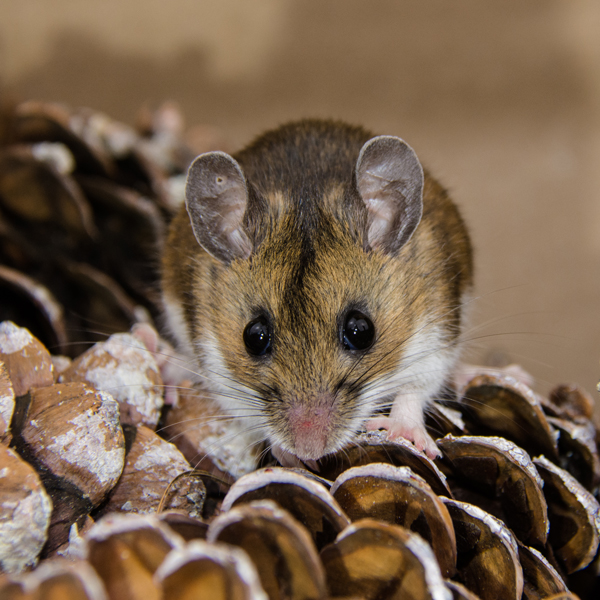
JAX Postdoc Scholar Raman Akinyanju Lawal, Ph.D. Photo by Thomas Fouchereaux.
Inbred mice have been central to biomedical research for decades, for many good reasons. They are quite different from humans on the outside, of course, but their mammalian genomes are largely similar to ours. Individuals within each mouse strain are nearly genetically identical, making it easy to reproduce experiments. It’s also relatively easy to manipulate mouse genomes, such as to target and knock out a specific gene, and create models for human diseases. Nonetheless, a vital limitation—the lack of genetic diversity within and between inbred mouse strains—has been increasingly recognized in recent years.
Researchers are now working to broaden the genetic diversity of mice used in research. Work with mice such as the Collaborative Cross inbred strains and Diversity Outbred populations represents important progress. But, surprisingly, the details of wild mouse genomic diversity remain largely unknown. Can more insight be gained by further exploring the genomic characteristics of wild house mice (Mus musculus) collected from their natural habitats? In “Selection shapes the landscape of functional variation in wild house mice,” published in BMC Biology, a team led by Jackson Laboratory (JAX) Assistant Professor Beth Dumont, Ph.D.Researching the mechanisms that generate genetic diversity through the lens of evolutionBeth Dumont, Ph.D., and Postdoctoral Associate Raman Akinyanju Lawal, Ph.D.Using cutting-edge sequencing technologies to support new biological discoveries. Interested in Bioinformatics, Pipeline Development, Long and Short Read Sequences, Computational Biology, Population and Evolutionary Genetics.Raman Akinyanju Lawal, Ph.D., analyze genome sequences generated from diverse wild house mouse populations from around the world. Their findings highlight how adaptations to different conditions and environments help to shape wild mouse genetic variation, including at human disease-associated genes.

Millions of genomic variants
Dumont and Lawal looked at 154 wild house mouse genomes collected from a variety of locations and habitats and including the three principle subspecies: Mus musculus musculus, Mus musculus domesticus and Mus musculus castaneus. Human-aided dispersal has rapidly expanded the Mus musculus range to the entire globe, driving local adaptation to very different local ecosystems with large differences in temperature, elevation, moisture, and more. These wild mouse genomes harbor significant genetic variability, including a total of about 154 million single nucleotide polymorphisms (SNPs), where single bases differ between mice. Most of the variants found in the wild mouse genomes are not present in the common inbred laboratory mouse strains. Of note, more than 13,000 variants found only in the wild mice were predicted to be highly deleterious, indicating potentially functional genetic variation in the wild mouse population.
Further inquiry found that just over 20% of the variants were population private, meaning they were unique to a particular region and subspecies. A survey of population private variants that are expected to affect function revealed high frequencies of mutations in certain disease-related genes in separate wild mouse populations. The evolution of natural loss-of-function gene variants could provide important insight into homologous human genes and associated diseases. The researchers also assessed where genetic diversity at certain genomic locations is reduced, which indicates strong positive selection for a particular allele (version of a gene) within a population. The scan for “selective sweep” signatures in the genomes revealed more than 1,000 putative sweep regions across the mouse populations. The regions contain genes for diverse biological functions, including metabolic pathways that might underlie dietary adaptations as mice began to frequently live — and travel — with humans over the past several thousand years, as well as genes implicated in Mendelian and complex human diseases.
Models for humans?
Inbred laboratory mice have been immensely valuable for biomedical research. Nonetheless, their limitations are important to note as researchers seek to translate findings to human clinical progress. The paper’s findings show that wild house mouse genomic variation largely mirrors that of human populations, shaped by geography, adaptation and natural selection. The recent evolutionary process has also influenced the distribution of likely disease-associated variation. The results can help prioritize the choice of wild mice from specific geographic areas to further explore gene function and associations with disease and to develop new, natural mouse models of human disease.